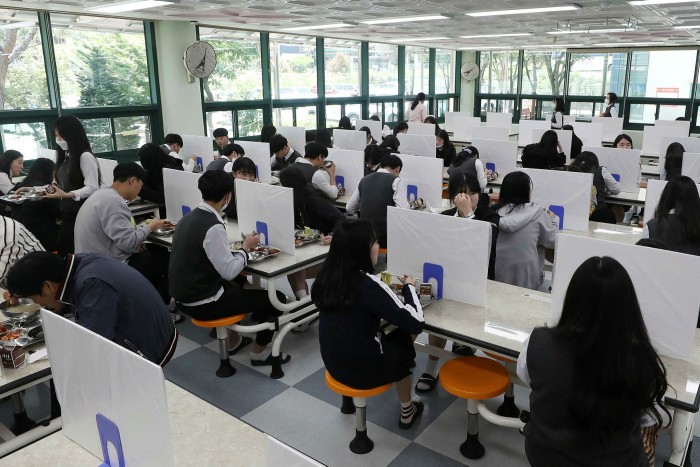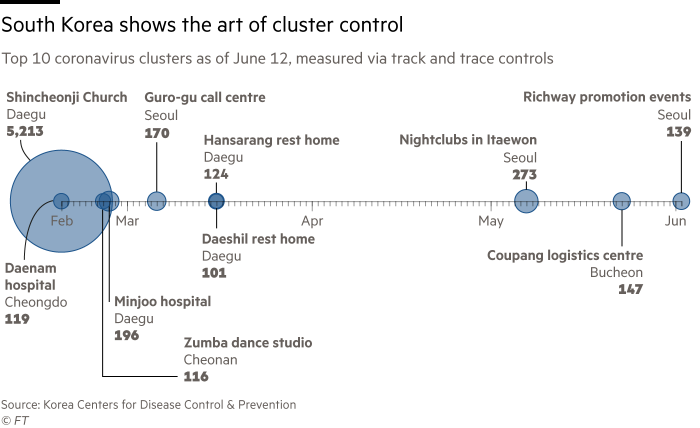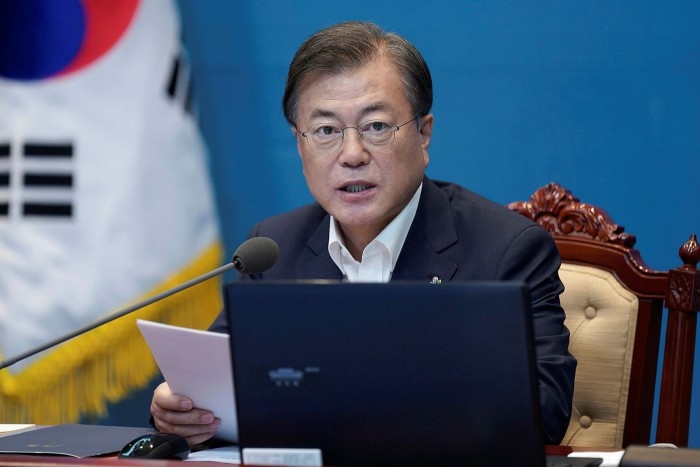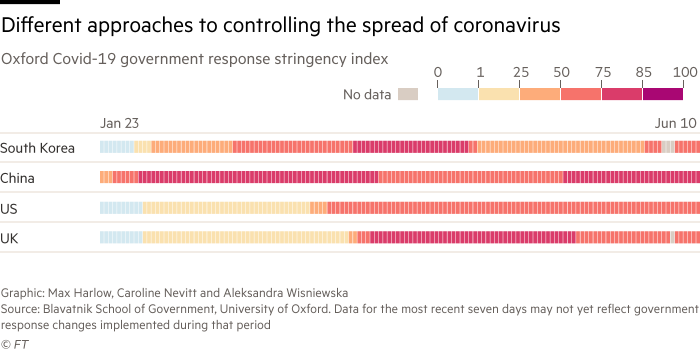A warning from South Korea: the ‘fantasy’ of returning to normal life | Free to read

Roula Khalaf, Editor of the FT, selects her favourite stories in this weekly newsletter.
By the time eight-year-old Lee Ji-ho is bundled out the door for his one day a week of in-class schooling, his mother has already completed an online form detailing his temperature, any signs of a cough or other respiratory complaints, and whether any family members have recently arrived home from overseas or are in quarantine.
Once at school in Seoul’s Seocho district, he sits metres apart from classmates and is instructed not to talk to friends — not even during lunch, where instead he eats in solitude, separated from the other children by a plastic divider.
The rigour faced by the young Ji-ho and his parents is just one example of an ever-expanding series of guidelines, rules and regulations imposed on a country of 52m by health officials desperately trying to avoid fresh waves of coronavirus.
It is more than three months since South Korea’s coronavirus infection rate peaked. In that time political leaders and health experts around the world have credited the government of President Moon Jae-in for teaching important lessons in the swift deployment of mass testing and aggressive contact tracing to counter what was for a time the worst Covid-19 outbreak outside of China.

Yet Seoul’s continued difficulty in controlling new outbreaks demonstrates that governments need a persistent state of vigilance and a willingness to change tack as they attempt to reopen their societies — a state of affairs that many people could find every bit as difficult as the lockdown itself.
South Korea has recorded just over 12,000 infections and fewer than 280 deaths while avoiding a national lockdown. Yet despite its relative success in reducing the spread of the virus, there have been an increasing number of outbreaks in recent months flaring up at churches, call centres, nightclubs, conference halls, logistics centres and even a Zumba dance studio.
“Coronavirus is constantly attacking society’s vulnerable classes and spaces,” says Park Won-soon, the mayor of Seoul. “We must shake off the fantasy that we can go back to the past we were accustomed to.”

The stark warning comes as governments from Madrid to Washington and London move beyond the initial public health crises and seek to plot a path out of crippling lockdowns — periods which have already sparked mass unemployment and sent large swaths of the global economy tumbling towards a deep recession.
This attempt to revive trade and commerce inevitably involves allowing much greater human interaction. Some experts are concerned that health systems remain vulnerable to being overwhelmed by the disease, especially in densely populated metropolises such as London and New York.
In the latest demonstration of the continuing risks, China, which has seen some of the most stringent virus control measures, is now facing its most serious upsurge in infections in months, with half of Beijing’s districts reporting new coronavirus cases on Monday.
Ben Cowling, a professor in epidemiology at Hong Kong University, says South Korea’s experience reflects that “governments are going to need to stay nimble” for the foreseeable future.

“As the numbers [of infections] go back up again, we know that early action in terms of bringing back social distancing is particularly effective, but [governments] are going to be reluctant to act so soon after relaxing measures,” he says. “Then, we are going to get into a cycle of needing more aggressive measures when case numbers get even higher.”
Learning to adapt
South Korea has been trying to avoid that cycle. Its daily infection rate hit a two-month high in late May, according to official data, a blow for the government that had just celebrated zero new local infections for several days a month earlier.
With most outbreaks occurring in Seoul, a sprawling city of 10m people, the emergence of these clusters spooked health and economic planners. Officials acknowledged that mistakes had been made — too many people had been allowed back into crowded spaces unchecked, and too early.
City officials have subsequently executed a series of U-turns and toughened controls. The return of school students to physical classrooms full-time has again been delayed. Nightclubs and bars — which had initially remained open — have been closed and access to public spaces such as museums, parks, conference halls and indoor sports facilities is restricted.

For the past two weeks the country’s daily infection rate has fluctuated between about 25 and 80. Seoul plans to keep its measures in place until the city again sees new infections fall into single digits. On the national level controls have also been strengthened, with the wearing of masks now mandatory in public transport and taxis. From last Wednesday, anyone entering one of about 80,000 bars, restaurants, nightclubs and other entertainment venues across the country has to register via a QR code, making it easier for officials to trace any large-scale outbreaks.
The rules were tightened despite huge pressure to fully open an economy suffering its steepest job losses since the aftermath of the 1997 Asian financial crisis. Gross domestic product is forecast to shrink 0.2 per cent this year, according to the country’s central bank, but the tougher controls underscore the priority given to public health.
Conceding that there have been setbacks, Seoul’s mayor believes the city is demonstrating to the world that economic reopening can only be achieved alongside stringent prevention and containment measures, as well as the humility to pivot, backtrack and admit mistakes.

“People can’t live alone at home forever . . . If we abide by strict disinfection and quarantine rules, check temperatures and wear masks, these [flare ups] are not likely to lead to massive outbreaks,” says Mr Park.
At Geumho-dong, just north of the Han river that slices across Seoul, staff from the Royal Singing Room, home to several floors of the country’s ubiquitous karaoke rooms, known as noraebang, disinfect each room between customers — microphones included.
Nearby, at Vogue 2, a basement-level computer gaming parlour, customers’ temperatures are checked on entrance and they are required to wear a mask. In the same neighbourhood, at Matdakko, a no-frills restaurant serving Korean staples of fried chicken and draught beer, employees regularly give similar treatment to every table, chair and door knob. Doors are kept open to increase air circulation, despite the stifling summer heat.
Spiritual life, too, has adjusted. In a country where more than half the population identify as religious, places of worship pose a key threat, exposing often elderly congregations more vulnerable to illness. At Palbok Presbyterian Church, in a quiet residential area of Incheon, a port city on Seoul’s outskirts, worshippers must register electronically before donning latex gloves and surgical masks to enter and quietly sit on the white spots marked out on the church’s wooden pews. The services have been cut from daily to twice a week.

Son Young-rae, a health ministry spokesperson, says it has become clear that the “only viable option” to enable economic activity to return while the virus persists is to “harmonise our daily lives with containment efforts”.
“People’s co-operation is essential for successful containment,” he says. “It is very important that citizens, businesses and institutions follow the rules.”
Contingency plans
When health officials were dispatched to Daegu, the country’s fourth-biggest city, in late February in a desperate attempt to track down members of the Shincheonji Church of Jesus who had been exposed to the virus, it took about two weeks to find and test 9,000 followers of the quasi-Christian sect — at the time the feat was impressive by international standards.
By late May, when workers fell ill at a logistics centre belonging to the country’s biggest ecommerce company, Coupang, a team of investigators, part of a Korean Centers for Disease Control and Prevention “rapid response” unit, were able to identify and test 5,000 people within three days.
The episode illustrates just how far the organisation has progressed in the speed and accuracy of its “trace and test” methods since the start of the outbreak. It is part of a broader series of improvements made across the bureaucracy, which has underpinned officials’ confidence in keeping most businesses and institutions open.

“In the case of the first patient in the Shincheonji cluster, it took about five to six days to find out her exact itinerary. But now we can get basic data in just 10 to 20 minutes,” says Mr Son, at the health ministry. “If we need to find out the itinerary of about 40 people who came into contact with a patient, we can do it within a day. It makes a big difference if you can do it within a day or a week. The slower the process is, the more people get infected.”
By comparison, in the UK — where the lockdown measures are slowly being lifted despite an average rate of 32,000 new infections every week since late April, according to official data — a similar manual contact tracing system remains largely untested, having only launched at the end of May and an associated app, promised for last month, remains marred by technical problems and delays.
Laws introduced after earlier public health shocks — Sars in 2003 and Mers in 2015 — allow the KCDC to access phone data, credit card records and CCTV footage to trace people’s movements, giving South Korean officials an advantage in how quickly they can act, compared with other countries with stricter privacy controls. With experience and greater resources, the rapid response teams’ capabilities have advanced significantly, according to Hwang Se-min, a doctor of preventive medicine turned Covid-19 investigator based at Sejong, the country’s de facto administrative capital.
“When a person tests positive, a team of two investigators immediately begins contact tracing. We go to the scene and check CCTV footage and look into who the patient was in contact with. We place those contacts under self-quarantine and test them. If those people test positive [after a few days], we start contact tracing again. We ask for their credit card data from the KCDC and check CCTV footage. We usually go through this cycle and try to finish their contact tracing within a day.”
The teams have identified and managed about 100 separate flare-ups or clusters and tested more than 1m people since February.
In an effort to snuff out future problems, Seoul city and the KCDC are currently expanding so-called “pooled testing” to facilities where they perceive a high risk of rapid contagion — such as care homes and crowded university dormitories. The pooled approach sees officials test about five to 10 people from the same facility at a time. If a single positive result is found, testing is quickly expanded to everybody at the site. The system was successfully used at scores of care homes in Daegu in April.
Cho Sung-il, a professor in chronic disease epidemiology at Seoul National University, says such pooled exercises could help in testing a much greater percentage of those people with the highest number of social contacts.

South Korean officials remain open to the reapplication of tougher social-distancing measures — such as homeworking, limited movement and more shop closures — if needed.
“We have a contingency plan for each phase of mass infections,” says Mr Son. “If the number of daily new cases surpasses 50 for two weeks straight, and the portion of patients infected through unclear transmission routes increases to more than 5 per cent of total cases, we are likely to go back to strict social distancing.”
Public health message
Elsewhere that might be more of a problem. Fatigue over social distancing has become common — especially in those countries where the threat to public health systems has eased and coronavirus infection rates have plateaued or started to fall. Health experts fear that if the infection rate rises, politicians will struggle to reassert stricter controls in the coming months or even years because of this public exhaustion and the acute economic strains already facing households and businesses.
The Black Lives Matter protests over racism and inequality that have swept through the US and other countries have further raised concerns among health experts that public awareness of the risks of Covid-19 and adherence to social distancing have decreased.
Jerome Kim, an immunology expert and director-general of the International Vaccine Institute in Seoul, says governments will need to have clear plans and thresholds for reinstating tougher measures, including more localised and targeted lockdowns, as well as find ways to keep the public aware of the risks.
“The real key is — why aren’t we getting the message across about the need to protect people?” he says.
Dr Kim also warns, however, that while the lockdowns were in one sense necessary for “flattening the curve” of infection rates, they should have also been used to give public health authorities “breathing room” to ensure adequate tracing, testing and protective equipment resources were all in place.
“In countries where that wasn’t necessarily done correctly, they do run the potential risk of large and uncontrolled outbreaks.”
Lee Ji-ho’s name has been changed at the request of his parents

Comments